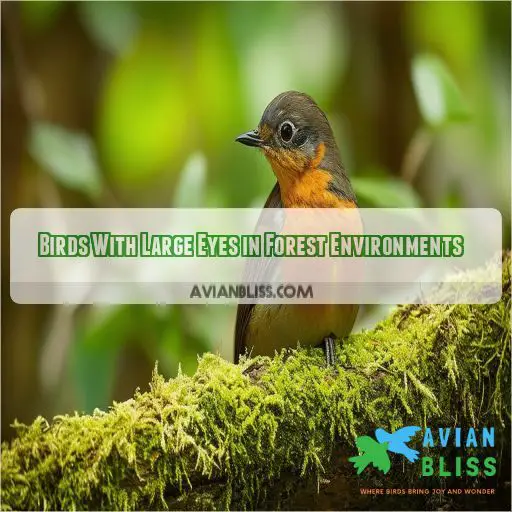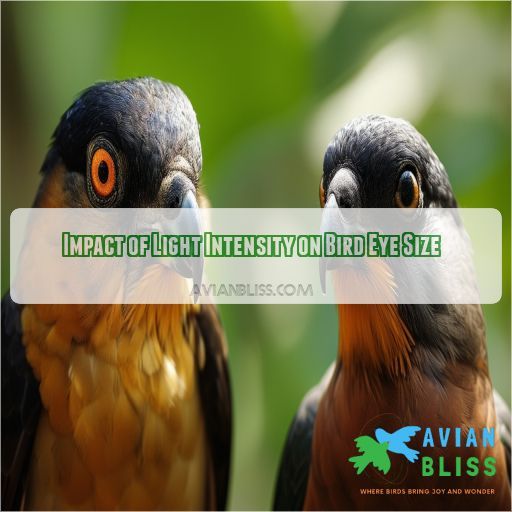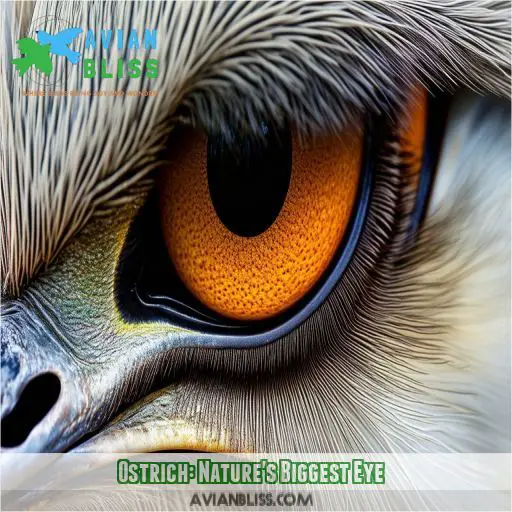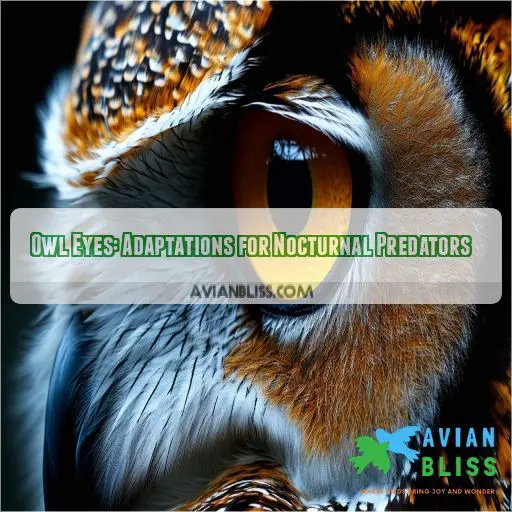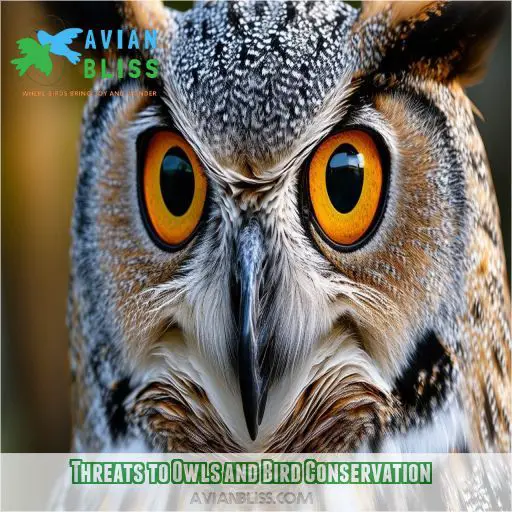This site is supported by our readers. We may earn a commission, at no cost to you, if you purchase through links.
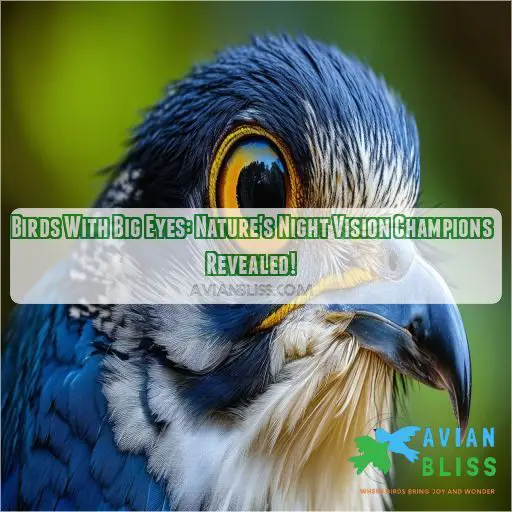 Ever wondered about the secret behind birds’ incredible night vision?
Ever wondered about the secret behind birds’ incredible night vision?
You’re about to discover the fascinating world of birds with big eyes, nature’s nocturnal champions. These remarkable creatures have evolved unique adaptations that allow them to thrive in low-light conditions.
From the massive eyes of ostriches to the specialized retinas of owls, you’ll learn how different bird species have developed their visual superpowers.
Explore the impact of eye size on behavior, habitat preferences, and hunting techniques in this eye-opening journey through avian evolution.
Table Of Contents
- Key Takeaways
- Birds With Large Eyes in Forest Environments
- Impact of Light Intensity on Bird Eye Size
- Ostrich: Nature’s Biggest Eye
- Owl Eyes: Adaptations for Nocturnal Predators
- Threats to Owls and Bird Conservation
- Frequently Asked Questions (FAQs)
- What kind of bird has a big eye?
- Which bird has big googly eyes?
- Why do potoos have big eyes?
- What type of bird has eyes that is bigger than its brain?
- How do big-eyed birds clean their eyes?
- Can birds with large eyes see ultraviolet light?
- Do big-eyed birds experience eye strain or fatigue?
- How do eye injuries affect birds with large eyes?
- Are there any flightless birds with unusually large eyes?
- Conclusion
Key Takeaways
- Big eyes aren’t just for show – they’re a bird’s secret weapon for ruling the night! From owls to ostriches, these feathered night owls have evolved super-sized peepers to catch every last ray of moonlight.
- Forest dwellers with saucer-like eyes are the ultimate undercover agents. They’re pros at spotting bugs and berries in the shadowy understory, but watch out – bright lights might leave them feeling like a deer in headlights!
- Talk about eye-popping facts: ostriches have eyeballs bigger than their brains! These savanna-dwelling giants can spot trouble from miles away, giving new meaning to the phrase "eyes in the back of your head."
- Owls are the true night vision champions, with eyes that’d make a cat jealous. These silent predators have pulled out all the stops – from light-amplifying layers to motion-sensing retinas – to become the ultimate nocturnal ninjas.
Birds With Large Eyes in Forest Environments
Ever wondered why some birds in forests seem to have eyes like saucers? You’re onto something!
In the dim, shadowy world of forest understories, birds have adapted to see in ways you’d never imagine. These avian understory specialists have evolved larger eyes to capture every bit of light filtering through the canopy.
It’s not just about looks; it’s a matter of survival. With bigger peepers, they’re equipped to spot insects, fruits, and potential predators in the low light.
But here’s the kicker: this adaptation comes with a catch. As forests are fragmented, these big-eyed beauties face challenges.
They’re not built for the bright lights of open areas, making them vulnerable to habitat changes. It’s a delicate balance between their specialized vision and the changing landscape they call home.
Impact of Light Intensity on Bird Eye Size
You might think all birds see the world the same way, but how much light they get really shapes their vision. As you walk through the forest, you’ll notice birds with bigger eyes doing great in darker spots. These big-eyed birds have evolved to grab more light, giving them an advantage in shady places. On the other hand, birds with smaller eyes rule brighter habitats, their compact eyes perfect for sun-filled canopies.
Here’s why light matters for our feathered friends:
- Big eyes = more light receivers = better night vision
- Small eyes = less glare = better daytime sight
- Eye size affects how they find food and spot danger
- How sensitive they’re to light influences where they live
This cool adaptation shows how clever nature is. As you watch birds flitting through the trees, remember: their eyes are like windows to their world, shaped by the light they use to get around. It shows us how powerful evolution is at fine-tuning bird vision for every corner of the forest.
Ostrich: Nature’s Biggest Eye
You’ve seen how light intensity affects bird eye size, but prepare to be amazed by the ostrich’s ocular prowess. These flightless giants boast the largest eyes of any land animal, dwarfing even their own brains! Evolved for survival in open savannas, ostrich eyes are a marvel of adaptation. Let’s compare these record-holding peepers to other creatures:
| Animal | Eye Diameter | Vision Range |
|---|---|---|
| Ostrich | 50 mm | 3.5 km |
| Horse | 40 mm | 1.6 km |
| Human | 24 mm | 1.6 km |
With eyes twice the size of yours, ostriches can spot predators from miles away. Their massive orbs are packed with photoreceptors, giving them razor-sharp vision across vast distances. This evolutionary advantage helps these birds thrive in their open habitats, proving that sometimes, bigger really is better in terms of bird vision!
Owl Eyes: Adaptations for Nocturnal Predators
While ostriches boast the largest eyes on land, owls have truly mastered the art of night vision. You’ll be amazed by how these nocturnal predators have adapted their eyes for hunting in the dark. Owl eyes are enormous relative to their body size, taking up a whopping 5% of their total weight! This adaptation allows them to gather more light, giving them superior vision in low-light conditions.
But size isn’t the only trick up their feathered sleeves. Owls have a unique eye structure that’s perfectly suited for their nocturnal lifestyle:
- A rod-packed retina that’s incredibly sensitive to movement
- A reflective layer called the tapetum lucidum that amplifies available light
- Forward-facing eyes that provide excellent depth perception for precise hunting
These adaptations make owls formidable nighttime hunters, able to spot and catch prey with astonishing accuracy in near-total darkness.
Threats to Owls and Bird Conservation
As you’ve learned about the incredible adaptations of owls, it’s important to understand the challenges they face.
Habitat loss and degradation pose serious threats to these night vision champions. You might be surprised to learn that over 2.9 billion breeding adult birds have vanished from North America alone.
It’s not just owls feeling the pinch; many bird species are in decline. Human activities, like urban development and agriculture, are eating away at their homes.
But don’t lose hope! Conservation efforts are in full swing, focusing on protecting important habitats and educating the public.
You can play a part too. By supporting bird-friendly policies and creating safe spaces in your backyard, you’re giving these big-eyed beauties a fighting chance.
Frequently Asked Questions (FAQs)
What kind of bird has a big eye?
Picture an owl’s piercing gaze in the night. You’ll find these nocturnal hunters have enormous eyes, perfectly adapted for low-light vision. Their large, forward-facing eyes give them exceptional depth perception, essential for swooping down on unsuspecting prey.
Which bird has big googly eyes?
You’ll find big googly eyes on the tawny frogmouth, a nocturnal bird native to Australia. Its large, yellow eyes give it a comical, surprised look. These eyes help it spot prey in low light conditions.
Why do potoos have big eyes?
Eyes like saucers, potoos don’t miss a beat. You’ll find their large peepers are perfectly suited for nocturnal hunting. They’re adapted to catch more light, helping these birds spot insects in the dark with ease.
What type of bird has eyes that is bigger than its brain?
You’ll be amazed to learn that ostriches have eyes bigger than their brains! These flightless birds boast the largest eyes of any land animal, measuring up to 50mm in diameter. They’ve evolved this trait for exceptional long-distance vision.
How do big-eyed birds clean their eyes?
You’ll find that big-eyed birds clean their eyes using a third eyelid called the nictitating membrane. It sweeps across the eye horizontally, removing debris and moistening the surface while still allowing some vision. It’s nature’s windshield wiper!
Can birds with large eyes see ultraviolet light?
Darkness and light intertwine in the avian world. You’ll find that many large-eyed birds can indeed see ultraviolet light. This ability enhances their perception, aiding in foraging, mate selection, and navigation through their environment.
Do big-eyed birds experience eye strain or fatigue?
You’re right to wonder about eye strain in birds. While they don’t experience fatigue like humans, big-eyed birds can face challenges in bright light. Their eyes are adapted for low-light conditions, potentially causing discomfort in intense sunlight.
How do eye injuries affect birds with large eyes?
Eye injuries can severely impact large-eyed birds, affecting their vision and survival. You’ll find that trauma, infections, or foreign objects can cause blindness, disorientation, and difficulty hunting. Getting them to a vet quickly is super important for these vulnerable creatures.
Are there any flightless birds with unusually large eyes?
You’ll find that ostriches, with their impressive eye size, stand out among flightless birds. Their eyes, larger than their brains, help them spot predators from afar. Kiwis, though flightless, have relatively small eyes for their body size.
Conclusion
Binocular brilliance in birds with big eyes opens up a world of nocturnal wonders.
You’ve explored how forest dwellers, ostriches, and owls have adapted their vision for low-light conditions.
You’ve learned how eye size impacts behavior and hunting techniques.
By understanding and appreciating these remarkable adaptations, you can contribute to bird conservation efforts.
Next time you’re out at night, listen for the soft hoots and rustling wings of nature’s nocturnal marvels.

